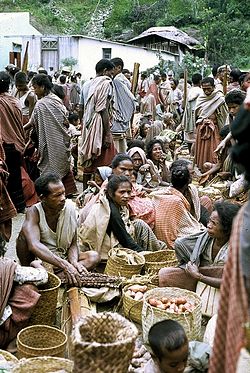Kemak people

Kemak people at the market in Atsabe, East Timor, circa 1968-1970.
|
|
| Total population | |
|---|---|
| (80,000) | |
| Regions with significant populations | |
|
Timor Island: Timor-Leste (68,800) West Timor, Indonesia (10,800) |
|
| Languages | |
| Kemak language | |
| Religion | |
| Christianity (94% in Timor-Leste, 90% in Indonesia), Folk religion (6% in Timor-Leste, 10% in Indonesia) | |
| Related ethnic groups | |
| Mambai people (Timor), Tokodede people |
The Kemak (Portuguese: Quémaque, also known as Ema) people are an ethnic group numbering 80,000 in north-central Timor island. They primarily live in the district of Bobonaro, East Timor, while the rest live in the East Nusa Tenggara province of Indonesia.
The Kemak people speak the Kemak language.
For the most part the Kemak live in Atabae, Cailaco, Maliana (Bobonaro District, 39,000 Kemaks) and Atsabe (Ermera District, 18,500 Kemaks), but also partly in the Cova Lima District (2,100 Kemaks) of East Timor and in Belu Regency, East Nusa Tenggara of Indonesia. According to the 2010 East Timor census, 61,969 people identify Kemak language as their mother tongue. In 1970, there were 45,084 people.
Before the colonial period, Atsabe was one of the centers of Timor under the koronel bote (meaning "Kings") of Atsabe Kemak, which dominated the entire Kemak inhabited areas in East Timor until the colonial period. The Kemak areas includes the north of present-day Bobonaro, in the northern Ainaro, and in the area of Suai that were tributary to Atsabe. The small Kemak empire of Marobo had a peripheral location, which is why the Kemak there were mixed with the neighboring Bunak people for generations. Atsabe was part of a complex alliance system through rituals, marriage and trade, though which the Tetun Dili people of Wehali with its capital, Laran were established. Laran was at the same time the spiritual center of the entire island. In addition to Tetum Dili and Kemak people, the Bunak people and Mambai people of Aileu were also part of this alliance system. Together with the east of the island, the Portuguese called this area Belu (also Belos or Behale).
...
Wikipedia
